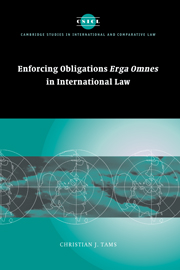Book contents
- Frontmatter
- Contents
- Foreword
- Preface
- Notes on citation
- Table of cases
- List of abbreviations
- Introduction
- Part I Background to the erga omnes concept
- Part II Legal issues raised by the erga omnes concept
- 3 Distinguishing types of erga omnes effects
- 4 Identifying obligations erga omnes
- 5 Standing to institute ICJ proceedings
- 6 Standing to take countermeasures
- 7 Erga omnes enforcement rights and competing enforcement mechanisms
- Conclusion
- Bibliography
- Index
- Cambridge Studies in International and Comparative Law
3 - Distinguishing types of erga omnes effects
Published online by Cambridge University Press: 24 July 2009
- Frontmatter
- Contents
- Foreword
- Preface
- Notes on citation
- Table of cases
- List of abbreviations
- Introduction
- Part I Background to the erga omnes concept
- Part II Legal issues raised by the erga omnes concept
- 3 Distinguishing types of erga omnes effects
- 4 Identifying obligations erga omnes
- 5 Standing to institute ICJ proceedings
- 6 Standing to take countermeasures
- 7 Erga omnes enforcement rights and competing enforcement mechanisms
- Conclusion
- Bibliography
- Index
- Cambridge Studies in International and Comparative Law
Summary
Before addressing the specific questions mentioned above, it is necessary further to delimit the field of analysis. Paradoxically, the need to do so is a consequence of the remarkable openness and success of the erga omnes concept. So far, it has been assumed that the concept affects the rules of standing and the invocation of responsibility. This approach indeed follows naturally from the wording and context of the above-quoted Barcelona Traction dictum. By mentioning ‘legal interests’ and ‘rights of protection’, the Court used terms that frequently appear in debates about standing and law enforcement. By distinguishing bilateral obligations in the field of diplomatic protection from obligations owed to the international community as a whole, it seemed to refer to these debates, and to the distinction between individual and general legal interests introduced above. However, it is crucial to note that erga omnes effects have been referred to in a variety of different situations, often entirely unrelated to questions of standing or law enforcement. Not all of these statements have received the same degree of attention. In fact, those of the Court's references that are hard to bring in line with the Barcelona Traction dictum are often either ignored or treated en passant. This eclectic approach is of course convenient – not the least it allows commentators exclusively to focus on erga omnes effects in the field of standing and law enforcement. However, eclecticism comes at the price of comprehensiveness.
- Type
- Chapter
- Information
- Enforcing Obligations Erga Omnes in International Law , pp. 99 - 116Publisher: Cambridge University PressPrint publication year: 2005



